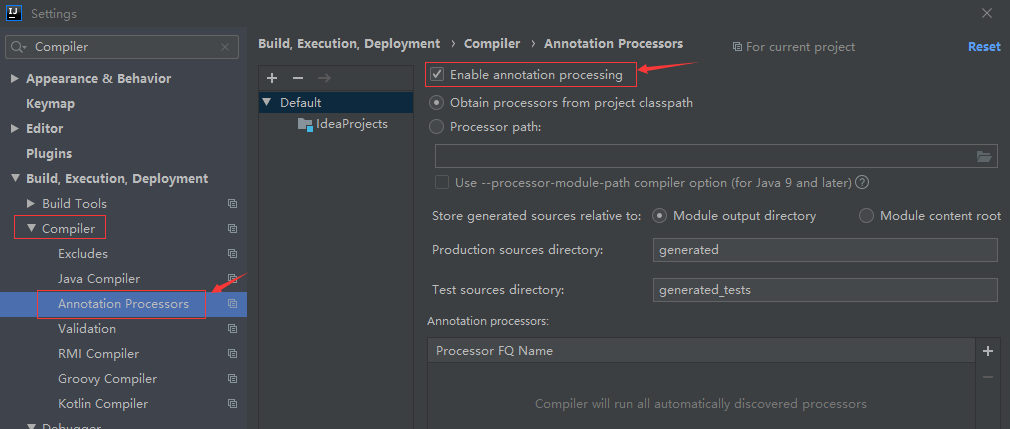
在JAVA开发中,因工作需要,你可能会学习或被迫去学习Lombok这个工具,这玩意用起来可以说是贼爽,很方便,可玄武老师实际上并不推荐大家使用,至于Lombok是什么?怎么入门?为什么不推荐使用?下面,玄武老师会慢慢跟你讲解。
一、Lombok是什么?
1、官方网站地址:https://projectlombok.org/
2、官网对Lombok的描述如下:
Project Lombok is a java library that automatically plugs into your editor and build tools, spicing up your java.
Never write another getter or equals method again, with one annotation your class has a fully featured builder, Automate your logging variables, and much more.
简单理解后说下意思:
Lombok项目其实就是一个java库,它可以自动插入到编辑器和构建工具中,增强java的性能。以后你只需要一些简单的注解,就可以再也不用在类中反复去写get、equals等方法。
3、优点说明:
Lombok能以简单的注解形式来简化java代码,提高开发人员的开发效率。例如开发中经常需要写的javabean,都需要花时间去添加相应的getter/setter,也许还要去写构造器、equals等方法,而且需要维护,当属性多时会出现大量的getter/setter方法,这些显得很冗长也没有太多技术含量,一旦修改属性,就容易出现忘记修改对应方法的失误。
Lombok能通过注解的方式,在编译时自动为属性生成构造函数、getter/setter、equals、hashcode、toString等方法。奇妙之处在于源码中没有getter和setter方法,但是在编译生成的字节码文件中有getter和setter方法。这样就省去了手动重建这些代码的麻烦,使代码看起来更简洁明了。
二、Lombok安装与使用
1、安装Lombok插件
Lombok插件支持Eclipse、IntelliJ IDEA、MyEclispe等IDE,在这里我们使用IntelliJ IDEA来演示安装:
1)打开File > Settings > Plugins >Marketplace,搜索Lombok,如图,点击install,弹窗Accept,然后安装好后Restart IDEA。

2)设置Enable annotation processing
打开File > Settings > Build, Execution, Deployment > Compiler > Annotation Processors,勾选Enable annotation processing,然后Apply和OK。

2、新建Java项目,引入jar包
1、常用jar包引入方法有两种,如下:
方法1:普通项目可以直接官网下载jar包,和使用普通jar包一样,导入项目即可。jar下载地址:https://projectlombok.org/download
方法2:Maven项目可以在pom.xml中配置依赖坐标即可,依赖坐标如下:
<dependencies>
<dependency>
<groupId>org.projectlombok</groupId>
<artifactId>lombok</artifactId>
<version>1.18.12</version>
<scope>provided</scope>
</dependency>
</dependencies>
注意:
1、<scope>provided</scope>表示该包只在编译和测试的时候用,项目真正打成包时不会将Lombok包打进去。
2、Lombok还支持其他构建方法,比如Ant、Gradle、Kobalt,有需要的可以参考官网的Install菜单下的Build Tools,其他使用方法也可以参考Install菜单
2、使用说明可以参考官方资料,也可以看我这里的常用注解代码演示(重点关注:@NonNull,@Getter, @Setter,@AllArgsConstructor,@NoArgsConstructor, @ToString和@Data)
1)@NonNull该注解用在属性或构造器上,Lombok会生成一个非空的声明,可用于校验参数,能帮助避免空指针。
示例代码:
//成员方法参数加上@NonNull注解,构造方法也一样,在此不做演示
public String getName(@NonNull Person p){
return p.getName();
}
实际效果相当于:
public String getName(Person p){
if(p==null){
throw new NullPointerException("person");
}
return p.getName();
}
2)@Getter和@Setter:在JavaBean或类JavaBean中使用,使用此注解相当于为成员变量生成对应的get和set方法,方法默认修饰符为public,同时还可以使用AccessLevel为生成的方法指定访问修饰符。这两个注解还可以直接用在类上,可以为此类里的所有非静态成员变量生成对应的get和set方法。
示例代码:
public class Student{
@Getter
@Setter
private String name;
@Setter(AccessLevel.PROTECTED)
private int age;
@Getter(AccessLevel.PUBLIC)
private String language;
}
实际效果相当于:
public class Student{
private String name;
private int age;
private String language;
public void setName(String name){
this.name = name;
}
public String getName(){
return name;
}
protected void setAge(int age){
this.age = age;
}
public String getLanguage(){
return language;
}
}
3)@Cleanup这个注解用在变量前面,可以保证此变量代表的资源会被自动关闭,默认是调用资源的close()方法,如果该资源有其它关闭方法,可使用@Cleanup(“methodName”)来指定要调用的方法。
示例代码:
public static void main(String[] args) throws IOException {
@Cleanup
InputStream in = new FileInputStream(args[0]);
@Cleanup
OutputStream out = new FileOutputStream(args[1]);
byte[] b = new byte[1024];
while (true) {
int r = in.read(b);
if (r == -1) break;
out.write(b, 0, r);
}
}
实际效果相当于:
public static void main(String[] args) throws IOException {
InputStream in = new FileInputStream(args[0]);
try {
OutputStream out = new FileOutputStream(args[1]);
try {
byte[] b = new byte[10000];
while (true) {
int r = in.read(b);
if (r == -1) break;
out.write(b, 0, r);
}
} finally {
if (out != null) {
out.close();
}
}
} finally {
if (in != null) {
in.close();
}
}
}
4)@ToString在JavaBean或类JavaBean中使用,使用此注解会自动重写对应的toStirng方法,默认情况下,会输出类名、所有属性(会按照属性定义顺序),用逗号来分割,通过callSuper参数来指定是否引用父类,includeFieldNames参数设为true,就能明确的输出toString()属性。
<code>@ToString(exclude=”column”)</code>
意义:排除column列所对应的元素,即在生成toString方法时不包含column参数;
<code>@ToString(exclude={“column1″,”column2″})</code>
意义:排除多个column列所对应的元素,其中间用英文状态下的逗号进行分割,即在生成toString方法时不包含多个column参数;
<code>@ToString(of=”column”)</code>
意义:只生成包含column列所对应的元素的参数的toString方法,即在生成toString方法时只包含column参数;;
<code>@ToString(of={“column1″,”column2”})</code>
意义:只生成包含多个column列所对应的元素的参数的toString方法,其中间用英文状态下的逗号进行分割,即在生成toString方法时只包含多个column参数;
示例代码:
复制代码
@ToString(exclude="id")
public class ToStringExample {
private static final int STATIC_VAR = 10;
private String name;
private Shape shape = new Square(5, 10);
private String[] tags;
private int id;
public String getName() {
return this.getName();
}
@ToString(callSuper=true, includeFieldNames=true)
public static class Square extends Shape {
private final int width, height;
public Square(int width, int height) {
this.width = width;
this.height = height;
}
}
}
实际效果相当于:
public class ToStringExample {
private static final int STATIC_VAR = 10;
private String name;
private Shape shape = new Square(5, 10);
private String[] tags;
private int id;
public String getName() {
return this.getName();
}
public static class Square extends Shape {
private final int width, height;
public Square(int width, int height) {
this.width = width;
this.height = height;
}
@Override
public String toString() {
return "Square(super=" + super.toString() + ", width=" + this.width + ", height=" + this.height + ")";
}
}
@Override
public String toString() {
return "ToStringExample(" + this.getName() + ", " + this.shape + ", " + Arrays.deepToString(this.tags) + ")";
}
}
5)@EqualsAndHashCode默认情况下,会使用所有非静态(non-static)和非瞬态(non-transient)属性来生成equals和hasCode,也能通过exclude注解来排除一些属性。
示例代码:
@EqualsAndHashCode(exclude={"id", "shape"})
public class EqualsAndHashCodeExample {
private transient int transientVar = 10;
private String name;
private double score;
private Shape shape = new Square(5, 10);
private String[] tags;
private int id;
public String getName() {
return this.name;
}
@EqualsAndHashCode(callSuper=true)
public static class Square extends Shape {
private final int width, height;
public Square(int width, int height) {
this.width = width;
this.height = height;
}
}
}
6)@NoArgsConstructor、@RequiredArgsConstructor和@AllArgsConstructor
这三个注解都是用在类上的,第一个和第三个都很好理解,就是为该类产生无参的构造方法和包含所有参数的构造方法,第二个注解则使用类中所有带有@NonNull注解的或者带有final修饰的成员变量生成对应的构造方法,当然,成员变量都是非静态的,另外,如果类中含有final修饰的成员变量,是无法使用@NoArgsConstructor注解的。
三个注解都可以指定生成的构造方法的访问权限,同时,第二个注解还可以用@RequiredArgsConstructor(staticName=”methodName”)的形式生成一个指定名称的静态方法,返回一个调用相应的构造方法产生的对象。
示例代码:
复制代码
@RequiredArgsConstructor(staticName = "myShape")
@AllArgsConstructor(access = AccessLevel.PROTECTED)
@NoArgsConstructor
public class Shape {
private int x;
@NonNull
private double y;
@NonNull
private String name;
}
实际效果相当于:
public class Shape {
private int x;
private double y;
private String name;
public Shape(){
}
protected Shape(int x,double y,String name){
this.x = x;
this.y = y;
this.name = name;
}
public Shape(double y,String name){
this.y = y;
this.name = name;
}
public static Shape myShape(double y,String name){
return new Shape(y,name);
}
}
7)@Data注解在类上,会为类的所有属性自动生成setter/getter、equals、canEqual、hashCode、toString方法,如为final属性,则不会为该属性生成setter方法。@Value注解和@Data类似,区别在于它会把所有成员变量默认定义为private final修饰,并且不会生成set方法。
官方实例如下:
@Data public class DataExample {
private final String name;
@Setter(AccessLevel.PACKAGE) private int age;
private double score;
private String[] tags;
@ToString(includeFieldNames=true)
@Data(staticConstructor="of")
public static class Exercise<T> {
private final String name;
private final T value;
}
}
实际效果相当于:
复制代码
public class DataExample {
private final String name;
private int age;
private double score;
private String[] tags;
public DataExample(String name) {
this.name = name;
}
public String getName() {
return this.name;
}
void setAge(int age) {
this.age = age;
}
public int getAge() {
return this.age;
}
public void setScore(double score) {
this.score = score;
}
public double getScore() {
return this.score;
}
public String[] getTags() {
return this.tags;
}
public void setTags(String[] tags) {
this.tags = tags;
}
@Override public String toString() {
return "DataExample(" + this.getName() + ", " + this.getAge() + ", " + this.getScore() + ", " + Arrays.deepToString(this.getTags()) + ")";
}
protected boolean canEqual(Object other) {
return other instanceof DataExample;
}
@Override public boolean equals(Object o) {
if (o == this) return true;
if (!(o instanceof DataExample)) return false;
DataExample other = (DataExample) o;
if (!other.canEqual((Object)this)) return false;
if (this.getName() == null ? other.getName() != null : !this.getName().equals(other.getName())) return false;
if (this.getAge() != other.getAge()) return false;
if (Double.compare(this.getScore(), other.getScore()) != 0) return false;
if (!Arrays.deepEquals(this.getTags(), other.getTags())) return false;
return true;
}
@Override public int hashCode() {
final int PRIME = 59;
int result = 1;
final long temp1 = Double.doubleToLongBits(this.getScore());
result = (result*PRIME) + (this.getName() == null ? 43 : this.getName().hashCode());
result = (result*PRIME) + this.getAge();
result = (result*PRIME) + (int)(temp1 ^ (temp1 >>> 32));
result = (result*PRIME) + Arrays.deepHashCode(this.getTags());
return result;
}
public static class Exercise<T> {
private final String name;
private final T value;
private Exercise(String name, T value) {
this.name = name;
this.value = value;
}
public static <T> Exercise<T> of(String name, T value) {
return new Exercise<T>(name, value);
}
public String getName() {
return this.name;
}
public T getValue() {
return this.value;
}
@Override public String toString() {
return "Exercise(name=" + this.getName() + ", value=" + this.getValue() + ")";
}
protected boolean canEqual(Object other) {
return other instanceof Exercise;
}
@Override public boolean equals(Object o) {
if (o == this) return true;
if (!(o instanceof Exercise)) return false;
Exercise<?> other = (Exercise<?>) o;
if (!other.canEqual((Object)this)) return false;
if (this.getName() == null ? other.getValue() != null : !this.getName().equals(other.getName())) return false;
if (this.getValue() == null ? other.getValue() != null : !this.getValue().equals(other.getValue())) return false;
return true;
}
@Override public int hashCode() {
final int PRIME = 59;
int result = 1;
result = (result*PRIME) + (this.getName() == null ? 43 : this.getName().hashCode());
result = (result*PRIME) + (this.getValue() == null ? 43 : this.getValue().hashCode());
return result;
}
}
}
8)@SneakyThrows这个注解用在方法上,可以将方法中的代码用try-catch语句包裹起来,捕获异常并在catch中用Lombok.sneakyThrow(e)把异常抛出,可以使用@SneakyThrows(Exception.class)的形式指定抛出哪种异常,很简单的注解,直接看个例子:
public class SneakyThrows implements Runnable {
@SneakyThrows(UnsupportedEncodingException.class)
public String utf8ToString(byte[] bytes) {
return new String(bytes, "UTF-8");
}
@SneakyThrows
public void run() {
throw new Throwable();
}
}
实际效果相当于:
public class SneakyThrows implements Runnable {
public String utf8ToString(byte[] bytes) {
try{
return new String(bytes, "UTF-8");
}catch(UnsupportedEncodingException uee){
throw Lombok.sneakyThrow(uee);
}
}
public void run() {
try{
throw new Throwable();
}catch(Throwable t){
throw Lombok.sneakyThrow(t);
}
}
}
9)@Synchronized这个注解用在类方法或者实例方法上,效果和synchronized关键字相同,区别在于锁对象不同,对于类方法和实例方法,synchronized关键字的锁对象分别是类的class对象和this对象,而@Synchronized得锁对象分别是私有静态final对象LOCK和私有final对象lock,当然,也可以自己指定锁对象,例子也很简单:
public class Synchronized {
private final Object readLock = new Object();
@Synchronized
public static void hello() {
System.out.println("world");
}
@Synchronized
public int answerToLife() {
return 42;
}
@Synchronized("readLock")
public void foo() {
System.out.println("bar");
}
}
实际效果相当于:
public class Synchronized {
private static final Object $LOCK = new Object[0];
private final Object $lock = new Object[0];
private final Object readLock = new Object();
public static void hello() {
synchronized($LOCK) {
System.out.println("world");
}
}
public int answerToLife() {
synchronized($lock) {
return 42;
}
}
public void foo() {
synchronized(readLock) {
System.out.println("bar");
}
}
}
10)@Log这个注解用在类上,可以省去从日志工厂生成日志对象这一步,直接进行日志记录,具体注解根据日志工具的不同而不同,同时,可以在注解中使用topic来指定生成log对象时的类名。不同的日志注解总结如下(上面是注解,下面是实际作用):
@CommonsLog
private static final org.Apache.commons.logging.Log log = org.apache.commons.logging.LogFactory.getLog(LogExample.class);
@JBossLog
private static final org.jboss.logging.Logger log = org.jboss.logging.Logger.getLogger(LogExample.class);
@Log
private static final java.util.logging.Logger log = java.util.logging.Logger.getLogger(LogExample.class.getName());
@Log4j
private static final org.apache.log4j.Logger log = org.apache.log4j.Logger.getLogger(LogExample.class);
@Log4j2
private static final org.apache.logging.log4j.Logger log = org.apache.logging.log4j.LogManager.getLogger(LogExample.class);
@Slf4j
private static final org.slf4j.Logger log = org.slf4j.LoggerFactory.getLogger(LogExample.class);
@XSlf4j
private static final org.slf4j.ext.XLogger log = org.slf4j.ext.XLoggerFactory.getXLogger(LogExample.class);
三、为什么不推荐使用Lombok?
Lombok的优点显而易见,可以帮助我们省去很多冗余代码,实际上,从潘老师个人角度来看,Java开发项目中,并不推荐使用Lombok,但潘老师还是介绍了它的使用方法,因为在一些公司存在这样的使用场景,下面我们来看一下潘老师为什么不推荐使用Lombok,它都有哪些缺点?
1) 高侵入性,强迫队友
Lombok插件的使用,要求开发者一定要在IDE中安装对应的插件。不仅自己要安装,任何和你协同开发的人都要安装。如果有谁未安装插件的话,使用IDE打开一个基于Lombok的项目的话会提示找不到方法等错误,导致项目编译失败。更重要的是,如果我们定义的一个jar包中使用了Lombok,那么就要求所有依赖这个jar包的所有应用都必须安装插件,这种侵入性是很高的。
2)代码可调试性降低
Lombok确实可以帮忙减少很多代码,因为Lombok会帮忙自动生成很多代码。但是,这些代码是要在编译阶段才会生成的,所以在开发的过程中,其实很多代码其实是缺失的。这就给代码调试带来一定的问题,我们想要知道某个类中的某个属性的getter方法都被哪些类引用的话,就没那么简单了。
3) 影响版本升级
Lombok对于代码有很强的侵入性,就可能带来一个比较大的问题,那就是会影响我们对JDK的升级。按照如今JDK的升级频率,每半年都会推出一个新的版本,但是Lombok作为一个第三方工具,并且是由开源团队维护的,那么他的迭代速度是无法保证的。所以,如果我们需要升级到某个新版本的JDK的时候,若其中的特性在Lombok中不支持的话就会受到影响。还有一个可能带来的问题,就是Lombok自身的升级也会受到限制。因为一个应用可能依赖了多个jar包,而每个jar包可能又要依赖不同版本的Lombok,这就导致在应用中需要做版本仲裁,而我们知道,jar包版本仲裁是没那么容易的,而且发生问题的概率也很高。
4)注解使用有风险
在使用Lombok过程中,如果对于各种注解的底层原理不理解的话,很容易产生意想不到的结果。举一个简单的例子:我们知道,当我们使用@Data定义一个类的时候,会自动帮我们生成equals()方法 。但是如果只使用了@Data,而不使用@EqualsAndHashCode(callSuper=true)的话,会默认是@EqualsAndHashCode(callSuper=false),这时候生成的equals()方法只会比较子类的属性,不会考虑从父类继承的属性,无论父类属性访问权限是否开放,这就可能得到意想不到的结果。
5)可能会破坏封装性
使用过程中如果不小心,在一定程度上就会破坏代码的封装性。举个简单的例子,我们定义一个购物车类,并且使用了@Data注解:
@Data
public class ShoppingCart {
//商品数目
private int itemsCount;
//总价格
private double totalPrice;
//商品明细
private List items = new ArrayList<>();
}
我们知道,购物车中商品数目、商品明细以及总价格三者之前其实是有关联关系的,如果需要修改的话是要一起修改的。但是,我们使用了Lombok的@Data注解,对于itemsCount 和 totalPrice这两个属性,虽然我们将它们定义成 private 类型,但是提供了 public 的 getter、setter 方法。
外部可以通过 setter 方法随意地修改这两个属性的值,我们可以随意调用 setter 方法,来重新设置 itemsCount、totalPrice 属性的值,这也会导致其跟 items 属性的值不一致。
而面向对象封装的定义是:通过访问权限控制,隐藏内部数据,外部仅能通过类提供的有限的接口访问、修改内部数据。所以,暴露不应该暴露的 setter 方法,明显违反了面向对象的封装特性。
好的做法应该是不提供getter/setter,而是只提供一个public的addItem方法,同时取修改itemsCount、totalPrice以及items三个属性。
因此,在此种情况下,就不适合使用Lombok,或者只用@Getter不用@Setter,而别直接使用@Data,在使用过程中,需要多多小心。
四、总结
Lombok虽好,但缺点也不少,如果你在公司团队开发中被强X了,你就只能使用,如果新项目开发,能不用就尽量别用了,否则坑也不少的!